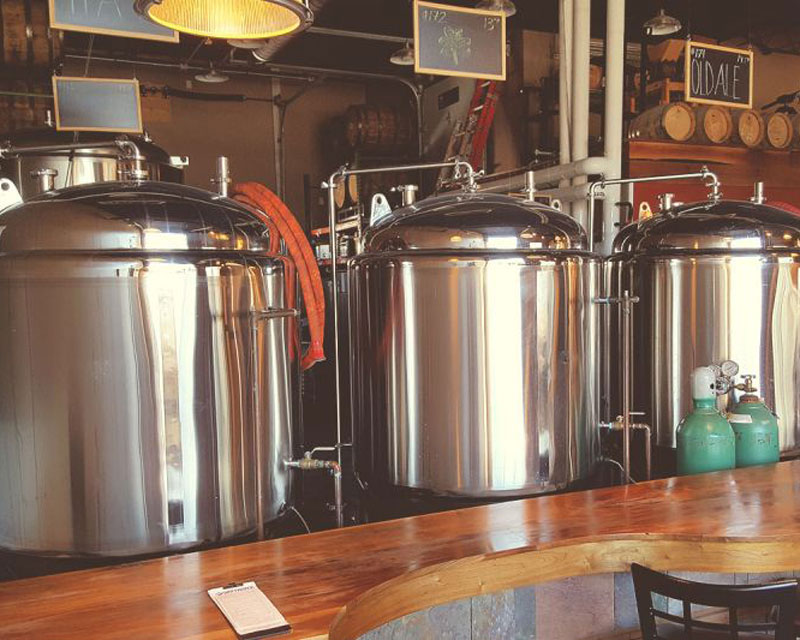Three Heads Brewing
Seeks to Improve Sustainability and Decrease Environmental Impact
 Three Heads Brewing is a craft brewery located in Rochester, New York. In 2019, annual production reached 7,700 barrels of beer. Three Heads’ owners desired to improve their company’s sustainability as part of their commitment to environmental stewardship. In February 2020, the New York State Pollution Prevention Institute (NYSP2I) at Rochester Institute of Technology (RIT) and Cornell University’s Cornell Enology Extension Laboratory (CEEL) conducted a site visit to collect data and identified cost-effective solutions to conserve water and energy, reduce toxic and hazardous materials, and manage wastes.
Three Heads Brewing is a craft brewery located in Rochester, New York. In 2019, annual production reached 7,700 barrels of beer. Three Heads’ owners desired to improve their company’s sustainability as part of their commitment to environmental stewardship. In February 2020, the New York State Pollution Prevention Institute (NYSP2I) at Rochester Institute of Technology (RIT) and Cornell University’s Cornell Enology Extension Laboratory (CEEL) conducted a site visit to collect data and identified cost-effective solutions to conserve water and energy, reduce toxic and hazardous materials, and manage wastes.
“NYSP2I has been great to work with. They spent lots of time looking into various areas of our brewery and created a game plan for improvement. NYSP2I brings a tremendous wealth of knowledge and practical experience. The industry stands to benefit from their innovative approach.” - Daniel Nothnagle, Three Heads Brewing Co.

Achievements to date
Three Heads produced 7,700 barrels of beer using 955,000 gallons of water in 2019, resulting in a water-to-beer ratio of 4:1. A 4:1 ratio is low for the industry and shows a strong commitment to responsible water use. Water-conservation efforts at Three Heads are largely focused on more efficient cleaning, which is how most water is spent at the brewery. Two highly effective strategies in place to achieve this include reusing water and caustic solution multiple times to clean kegs and using control measures to determine when final rinsing is complete. This eliminates unnecessary water that might be spent rinsing, resulting in significant water savings.
Reduction of waste is common in the craft-brewing industry and Three Heads is no exception. To reduce spent yeast waste, Three Heads brewers reuse yeast five times on average. The brewery also has a grain silo, reducing the amount of plastic grain bags discarded. Energy efficiency is achieved through the use of a natural-gas steam boiler equipped with a water-softening system. Steam is the most efficient source of heating for large applications and softened water avoids costly maintenance and efficiency losses.

Opportunities
After performing a site assessment of Three Heads, NYSP2I and CEEL specialists made a series of recommendations to improve the brewery’s sustainability strategy. These are listed below.
To reduce water and chemical use:
- Collect the final rinse of a cleaning and reuse it as the first rinse of the next one. The final rinse is always the cleanest because it has the least amount of contaminant. Using it for the first and dirtiest rinse results in effective cleaning and requires no additional water. Before full-scale implementation, tests should be performed to confirm that cleanliness standards are met.
- Install low-flow nozzles, spray balls, sinks, and toilets in the facility to reduce water consumption. It is recommended that the new fixtures be piloted to ensure that they meet performance expectations.
To be more energy-efficient:
- Invest in a heat exchanger. A heat exchanger allows for energy to be “recycled” from one process and applied to another. An example of this in the brewing sector is using hot wort to preheat water for use in brewing or cleaning. This results in less natural gas spent heating water, and less electricity used to chill pre-fermentation fluids, since the wort would cool as a result of the exchange process.
- Request the data from utilities companies used to calculate the demand charges. A facility that consumes a lot of electricity over a short period of time typically results in “demand charges” from a utilities company. Three Heads can better understand and optimize their energy consumption by identifying the processes that draw the most electricity.





